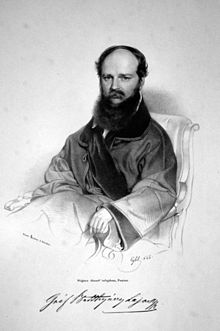Lajos Batthyány


Lajos Batthyány von Németújvár (born February 10, 1807 in Pressburg ; † October 6, 1849 in Budapest ) was a Hungarian magnate , count and lord of the rule Ikervár, Schlaining and Neuhaus as well as Erbobergespan (Hungarian főispán ) of Eisenburg County (Hungarian Vas vármegye ) and first Prime Minister of the Kingdom of Hungary .
Life
Lajos Batthyány came from the old and widely ramified Hungarian noble family Batthyány , who later belonged to the most important families in Austria and Hungary as magnates, counts and princes . He first attended the Schottengymnasium in Vienna , then took up the military profession, left the military in 1827 and managed his estates. At the same time he studied law and passed the exam at the Zagreb Academy .
From 1830 he took part in the session of the Hungarian parliament in Pressburg as a member of the table of magnates . On December 4, 1834, he married Antonie de Vazsonkő, née Zichy. In the years 1832-1836 he was already an important member of the opposition. In 1847 he was elected chairman of the reformers. As such, he fought resolutely for the rights of the Hungarian people and for an independent government and constitution. However, he was not an advocate of violent action; instead, as a moderate reformer, he wanted to achieve the goal through planned negotiations with the Vienna government. His attitude followed the political program of István Széchenyi more than the demands of Lajos Kossuth . Széchenyi warned his compatriots about the consequences of language nationalism and a separation from Austria. Kossuth was a revolutionary and insisted on the Magyarization of ethnic minorities.
After the outbreak of the March revolutions in 1848 , the wishes of the Hungarian nation were presented to King Ferdinand V in Vienna by the Hungarian state parliament in Pressburg . Hungary had to be granted an independent government, Batthyány was appointed the first Hungarian Prime Minister on March 22, 1848. After the new government began its work, the Hungarian Revolution intensified because of overly high national claims. In the course of a simultaneous pan-Slavist counter-movement, which ultimately even sought to detach the Slavic parts of the country from the Kingdom of Hungary , Croatian troops under their Banus Jelačić came to the aid of the emperor and marched into Hungary on September 9, 1848. After the murder of Count Lamberg , the newly appointed military commander for Hungary by the emperor , a state of siege was imposed on Hungary on October 3rd .
In order to end Hungary's attempts at separation, an imperial army under Count Windischgrätz with 90,000 soldiers advanced in the direction of Ofen in mid-December 1848 .
On January 3, 1849, Batthyány went to the imperial headquarters in Bicske together with other Reichstag deputies , but was called a rebel by Field Marshal von Windischgrätz and was no longer received. He remained in Pest for the next few days in complete calm, without using the opportunity to escape to Debreczin. On January 8th, however, he was seized by the imperial army in Count Károlyi's palace and locked in a barracks in a furnace. In the further course of the War of Independence , at the beginning of May 1849, Tsarist Russia came to the aid of the Austrians with around 150,000 soldiers under Prince Paskewitsch . The encircled Hungarian army was no longer able to cope with the superior strength of the enemy . After the surrender of Vilagos in August 1849, Kossuth and Artúr Görgey had to flee to the Ottoman Empire with 4,900 officers and soldiers . Batthyány even paid homage to the new Emperor Franz Joseph I to stop further bloodshed. He remained under house arrest and was shot in Pest on October 6, 1849 at the massive instigation of the imperial commander in chief in Hungary, Baron Julius von Haynau . The execution sparked worldwide outrage. Along with Batthyány, 13 more generals (the so-called martyrs of Arad ) were killed that day . October 6, 1849 is considered a national day of mourning in Hungary . A few days later, Batthyany's body was buried in the crypt of the Pest Franciscan Church.
After the compromise with Austria , he was solemnly buried on June 9, 1870 in a mausoleum on the Kerepesi temető . At the place of his execution an eternal light burns in memory of the Hungarian martyr .
In the third part of the Sissi trilogy Fateful Years of an Empress , author and director Ernst Marischka assigned him the role of a rebel, whose son is soothed by the charm and kindness of the Empress Elisabeth, who was also Queen of Hungary.
literature
- Constantin von Wurzbach : Batthyány, Ludwig Graf . In: Biographisches Lexikon des Kaiserthums Oesterreich . 1st part. University printing house L. C. Zamarski (formerly JP Sollinger), Vienna 1856, pp. 180–182 ( digitized version ).
- Batthyány . In: Meyers Konversations-Lexikon . 4th edition. Volume 2, Verlag des Bibliographisches Institut, Leipzig / Vienna 1885–1892, p. 453.
- Batthyány Count Ludwig. In: Austrian Biographical Lexicon 1815–1950 (ÖBL). Volume 1, Verlag der Österreichischen Akademie der Wissenschaften, Vienna 1957, p. 53.
- László Révész: Batthyány, Lajos Graf . In: Biographical Lexicon on the History of Southeast Europe . Vol. 1. Munich 1974, p. 161 f.
- I. Fazekas, S. Malfèr, P. Tusor (eds.): Széchenyi, Kossuth, Batthyány, Deák. Studies on the Hungarian reform politicians of the 19th century and their relations with Austria , publications by Hungarian historical research in Vienna, Vol. 3, Collegium Hungaricum, Vienna 2011, ISBN 978-963-88739-6-5 .
Web links
| personal data | |
|---|---|
| SURNAME | Batthyány, Lajos |
| ALTERNATIVE NAMES | Batthyány from Németújvár, Lajos |
| BRIEF DESCRIPTION | Hungarian magnate and prime minister |
| DATE OF BIRTH | February 10, 1807 |
| PLACE OF BIRTH | Pressburg |
| DATE OF DEATH | October 6, 1849 |
| Place of death | Budapest |

